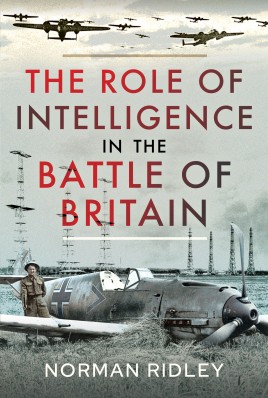
The Role of Intelligence in the Battle of Britain. By Norman Ridley. Air World, an imprint of Pen & Sword, Barnsley, 2021. ISBN 978 1 39901 038 2
Reviewed by David Hobbs
Sometimes, but happily not often, a review book contains a glaring error that leaps out from the page. If the author got a simple fact like that wrong, one wonders, how many other errors are there? There is just such a mistake on page 94 of this book where the author states that ‘the British Home Fleet was anchored at Scapa Flow in the Shetland Island’ (sic).
Scapa Flow is, of course, in the Orkney Islands and the author gives the impression that the Home Fleet’s move there was an example of ‘how poor intelligence adversely affected the operations of the British military’. The Admiralty had apparently been told that up to 800 bombers ‘were within range’ and the accusation of poor intelligence presumably refers to the number of bombers rather than their ability to reach the fleet’s base. Scapa Flow was one of the first targets in the UK to be attacked but no mention is made of the fact that it was the Home Fleet’s principal base, chosen for its strategic position between the North Sea and the Atlantic. Up to that point I had read the book with interest but the error set me thinking and from then on I noted that no mention is made of the cruisers, destroyers and coastal forces that patrolled the narrow seas as an important element of British anti-invasion measures in 1940. Knowledge of enemy movements derived from intelligence sources was a significant factor in deciding on their readiness and operational use, for example in the attacks by both warships and aircraft against the concentrations of enemy troops near newly-captured harbours. Similarly there is no mention of the patrols by aircraft of RAF Coastal Command during the same period which contributed to the intelligence appreciation of enemy movements.
To be fair the author does devote chapters to descriptions of the German Enigma code machine and the activities of Polish code-breakers but his definition of the term ‘Battle of Britain’ is a narrow one, essentially limited to the fighting between the German Luftwaffe and Fighter Command of the RAF. Even the actions of other RAF commands, let alone the vital contributions made by the Royal Navy and the Army during this period are not given the coverage they deserve. Surprisingly, there is little mention of the Joint Intelligence Committee or the Chiefs of Staff and their policy decisions based on the wide range of intelligence material available to them from every source. The author interprets the detection of enemy aircraft heading for the UK to be a source of intelligence and takes great pains to describe the development of the British Chain Home and Chain Home Low radar systems and the techniques used by Fighter Command to control its fighters. The author’s decision to limit the intelligence aspects of the battle to those that could be viewed through the lens of Fighter Command activities means that several fascinating aspects of the intelligence war are omitted. Alert states, the positioning and control of anti-aircraft guns and balloon barrages, the use of warships and aircraft to lay minefields and strike at enemy concentrations, the use of air reconnaissance and even aircraft recognition training were all inspired to some extent by intelligence reaching the UK or the lack of it. They could have been woven into a more detailed story to offer a more complete picture.
Goring and the part he played are described in detail, as is the fragmented nature of the Luftwaffe intelligence organisations but not the RAF command structure and order of battle. It is Dowding, the C-in-C of Fighter Command who is described, and then only briefly, and not the Chief of the Air Staff. There are references to RAF policy and equipment but some of them are incorrect. For instance on page 115 the Fairey Battle light bomber is described as being the intended recipient of the Rolls-Royce Griffon engine. The author is confusing two projects here; the Battle was the first aircraft to be ordered in quantity with Rolls-Royce Merlin engines and it was to fulfil this contract that the Merlin entered large-scale production for the first time. The Griffon was intended as a higher-powered Merlin replacement and took some years to develop. The extent that pre-war intelligence influenced aircraft design and procurement prior to 1939 might have been an interesting theme to develop but the author only touches upon it lightly.
The chapter on Enigma describes the well-known code-breaking activities at Bletchley Park and the author explains that after the fall of France in June 1940 the Germans began to use secure land-line communications rather than radio and this limited the number and quality of signals available for experts to decipher. More on the ‘Sigint’ activities of ‘Y’ groups who provided the raw material for decryption and were able to pass on tactical material in their own right would have been interesting. Quite rightly he mentions the limitations imposed by the lack of experienced intelligence officers but does not dwell in any depth on how attempts were made to overcome them. The book’s sources are revealed as notes from page 244 and as a three-page list from page 241. They are all published secondary sources with no primary material. There is, therefore, nothing that reflects new research into the subject matter from recently-released papers. Whilst containing obvious errors and a scope limited to one aspect of a complex series of operations this book does, however, offer useful insight into the failures of German intelligence and Goring’s ill-informed interventions, both of which had significant impacts on operations. It may, therefore, appeal to readers who want to take a first look at the subject. Beware of those errors though.



